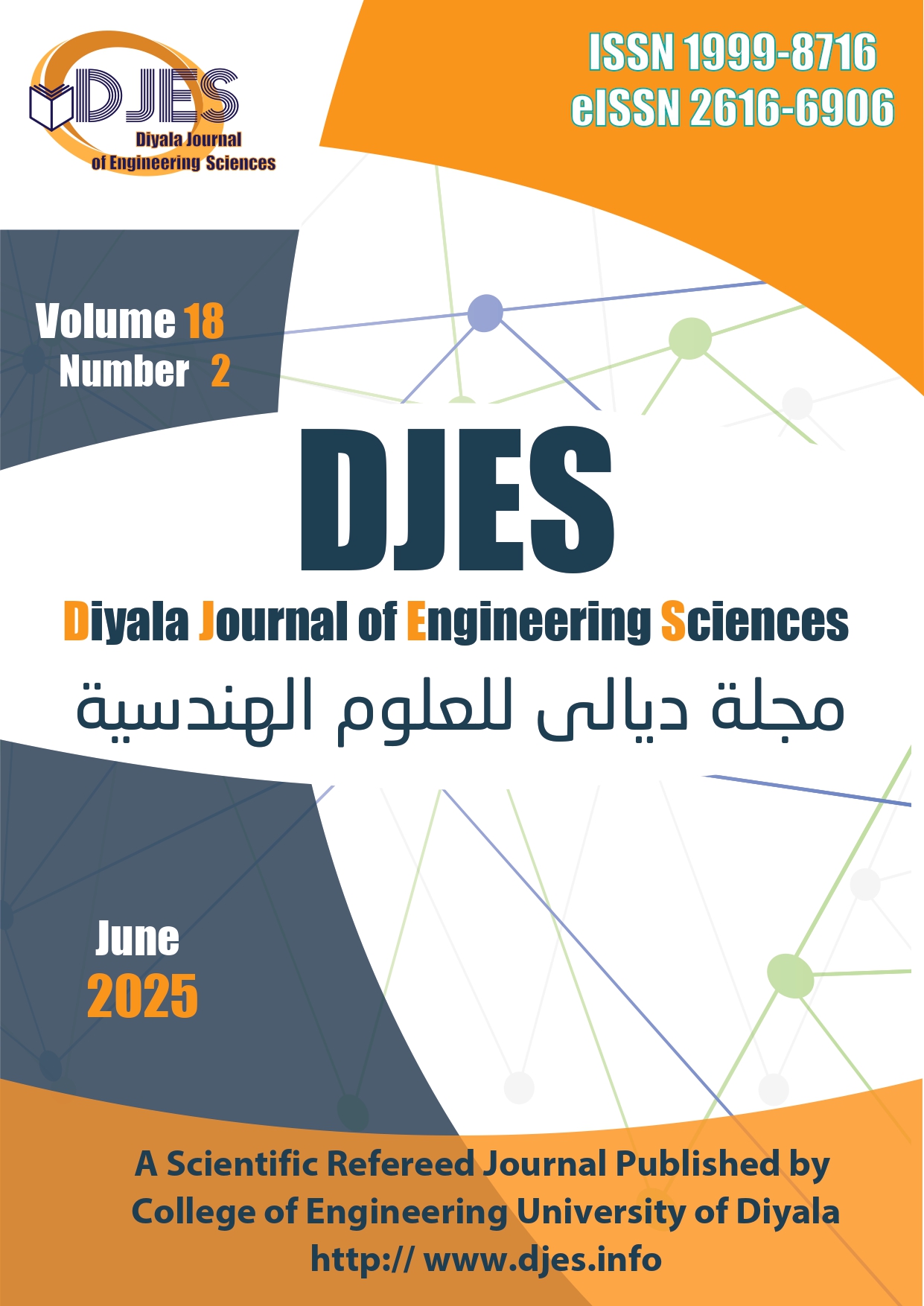Design and Simulation of a 12 GHz Two-Stage LNA for Ku-Band Telecommunication Applications
DOI:
https://doi.org/10.24237/djes.2024.18204Keywords:
ADS software, GaAs FET, Low noise amplifier, Matching network (MN), Microstrip technology, Multi stage, Noise figureAbstract
The Low Noise Amplifier (LNA) is typically the initial step in any microwave receiver circuit and is crucial to the receiver's quality. The design, analysis, and modeling of single-stage and multi-stage low-noise amplifiers combined with an optimal matching network at wideband frequencies between 11 - 13 GHz are presented in this study. The amplifier circuit's heart, the embedded GaAs FET transistor MGF2407A in Advance Design System tool, operates in class AB mode with a drain source voltage of 4 V and a gate source voltage of -0.2 V. The matching circuit was constructed and optimized at the transistor's input and output after the source and load impedances were extracted using the source and load-pull technique. The stability factor of simulated amplifier was greater than 4 in the 11–13 GHz frequency range. The noise figure (NF) and power gain at 12 GHz were 34 dB and 0.391, respectively. The input and output sides have exceptionally low reflection coefficients, with values below -15 dB. According to simulation results, the LNA has a broad bandwidth of 2 GHz and an acceptable NF between 0.5 and 0.3 within the bandwidth range of the Ku-Band applications. This amplifier circuit model can be used to create and build various LNA circuits for a variety of uses.
Downloads
References
[1] C. Shorten and T.M. Khoshgoftaar, “Design and Simulation of Low Noise Amplifier at 2.3 GHz Frequency for 4G Technology”, International Journal of Advanced Research in Electrical. Electronics and Instrumentation Engineering, vol. 4, no. 6, June 2015 (DOI: 10.15662/ijareeie.2015.0406048).
[2] M. Fallahnejad, A. Kashaniniya, “Design of Low Noise Amplifiers at 10 GHZ and 15 GHZ for Wireless Communication Systems”, Journal of Electrical and Electronics Engineering, vol. 9, no. 5, (Sep - Oct) 2014 (DOI: 10.9790/1676-09544753).
[3] V. Janvier, et al, “Two-stage 24 GHz Low Noise Amplifier for Front-End Receiver System”, International Conference on Sciences of Electronics, Technologies of Information and Telecommunications, Boumerdes, Algeria. University of Boumerdes, 2012. (DOI: 10.1109/SETIT.2012.6481921).
[4] Y. Taryanaand, et al, “Design of Two Stage Low Noise Amplifier Using Double Stub Matching Network”, IEEE International Conference on Aerospace Electronics and Remote Sensing Technology, Research Center for Electronics and Telecommunication, 2015 (DOI: 10.1109/ICARES.2015.7429833).
[5] G. Nikandish, et al, “A Broadband Multistage LNA With Bandwidth and Linearity Enhancement”, IEEE Microwave and Wireless Journal, 2016. (DOI: 10.1109/LMWC.2016.2605446).
[6] Ruchita Kumari, et al, “A 0.5 V LNA Design for 2.4 GHz Wireless Body Area Network Applications”, International Conference on Electronics Communication and Aerospace Technology, University of Saskatchewan, Saskatoon, Canada, 2019. (DOI: 10.1109/ICECA.2019.8821857).
[7] M. Challal, et al, “Two-stage 24 GHz Low Noise Amplifier for Front-End Receiver System”, International Conference on Sciences of Electronics, Technologies of Information and Telecommunications, Bangalore, India, 2012. (DOI: 10.1109/SETIT.2012.6481921).
[8] H.T. Friis, “Noise figures of radio receivers”, Proc. IRE, Volume 32, July 1994 (DOI: 10.1109/JRPROC.1944.232049).
[9] V. Murthy, et al, “Ultra Low Noise Figure, Low Power Consumption Ku- Band LNA with High Gain for Space Application”, International Conference on Communication and Electronics Systems, Auckland University of Technology, 2020. (DOI: 10.1109/ICCES48766.2020.9137956).
[10] Y. Sulaeman, et al, “S-Band Two Stage Low-Noise-Amplifier using Single Stub Matching Network”, International Conference on Radar, Antenna, Microwave, Electronics, and Telecommunications, Research Center for Electronics and Telecommunication Indonesian Institute of Sciences Kampus, 2016. (DOI: 10.1109/ICRAMET.2016.7849583).
[11] Arch. H. Neuckermans, “RF Power Amplifiers for Wireless Communications”, 2nd Edition, Artech-Publisher, Katholieke University Leuven, Belgium, 2008 (ISBN: 9781596930193).
[12] Y. Parwath, “Design of a 5.8 GHz Two-Stage Low Noise Amplifier”, Thesis, California State University, Northridge, 2020.
[13] P. Kumar, et al, “Design of a Two Stage Ku Band Low Noise Amplifier for Satellite Applications”, International Conference on Communication and Signal Processing, 2015 (DOI: 10.1109/ICCSP.2015.7322884).
[14] R. Islam, et al, “Design of a Low Noise Amplifier with GaAs MESFET at ku_Band”, International Conference on Computer and Communication Engineering, Kuala Lumpur, Malaysia, 2010. (DOI: 10.1109/ICCCE.2010.5556786).
[15] Z. Chen, et al, “Design of Ku-Band Low Noise Amplifier for Satellite Communication Applications”, International Conference on Integrated Circuits and Microsystems, Nanjing, China, 2021. (DOI: 10.1109/ICICM54364.2021.9660315).
[16] D. Maxwell, et al, “A Two-Stage Cascode CMOS LNA for UWB Wireless Systems”, IEEE Conference, University of Texas, 2005. (DOI: 10.1109/MWSCAS.2005.1594179).
[17] Agilent Technology, “Low Noise Pseudomorphic HEMT - in a Surface Mount Plastic Package”, TF13843 Data Sheet. 2007. (DOI: 10.1109/MWSCAS.2005.1594179).
[18] K.R.Samatha, et al, “A Novel Input Output Impedance Matching Network for LNA”, International Conference on Communication and Signal Processing, Sathyabama University, Chennai, India, 2016. (DOI: 10.1109/ICCSP.2016.7754546).
[19] Yuanxun Wang, et al, “A High Efficiency Power Amplifier System for CDMA”, Fujitsu Sci. Tech., Volume 48, No. 2, July 2012. (DOI: 10.1109/EUMA.2002.339395).
[20] X. Liu, et al, “Co-design of power amplifier and narrowband filter using high-Q evanescent-mode cavity resonator as the output matching network”, IEEE MTT-S Int. Microwave, July 2011. (DOI: 10.1109/MWSYM.2011.5972854).
[21] U. L. Rohde and D. P. New Kirk, “RF Microwave Circuit Design for Wireless Application”, England: John Wiley & Sons; 2000. (ISBN:9780471298182)
[22] M. Iyer, et al, “LNA Design for WLAN Applications”, IEEE International Conference on Circuits and Systems, Pondicherry University, Puducherry, India, 2017. (DOI: 10.1109/ICCS1.2017.8326013).
[23] T.R. Al-Shaikhli, et al, “Integrated of Low Noise Amplifier and Notch Filter for Wireless Communications”, International Journal of Applied Engineering Research, Volume 12, Issue 23, PP 14690 - 14695, 2017.
[24] G. Gonzalez, “Microwave Transistor Amplifiers Analysis and Design”, second edition: Prentice-Hall; 1997. (ISBN-10. 0132543354)
[25] Chen and Q. Feng, “A new configuration of differential CMOS LNA”, Electromagnetic Research Symposium: Cambridge; 2008. (DOI: 10.1109/INDIN.2008.4618179).
[26] Amina Msolli, et al, “Ultra low power low noise amplifier design for 2.4 GHz applications”, 7th International Conference on Design & Technology of Integrated Systems in Nanoscale Era, May 2012. (DOI: 10.1109/DTIS.2012.6232962).
[27] R. Dai., et al, “Design and Layout of a X-Band MMIC Power Amplifier in a Phemt Technology”, World Academy of Science, Engineering and Technology; 2006.
[28] M. Iyer, et al, “GaAs FET Based LNA Design for WiMAX Applications” IEEE International Conference on Current Trends Toward Converging Technologies, Pondicherry University, Coimbatore, India, 2018. (DOI: 10.1109/ICCTCT.2018.8550887).
[29] Li Gao and others, “Compact Power Amplifier with Bandpass Response and High Efficiency”, IEEE Microwave and Wireless Components Letters, 24 (10): 707–709, 2014.
[30] M. Iyer, et al, “LNA Design for 3 cm Band Applications”, IEEE International Conference on Current Trends Toward Converging Technologies, Pondicherry University, Coimbatore, India, 2018. (DOI: 10.1109/ICCTCT.2018.8550891).
[31] W. Liou, et al, “A Wideband LNA Design for Ku-Band Applications”, IEEE, National Taipei University, Taiwan, China, 2010. (DOI: 10.1109/ICCCAS.2010.5581910).
[32] W. Liou, et al, “A Ku-band low noise amplifier implemented in 0.15 μm Gallium Arsenide pHEMT process”, IEEE Microwaves, Antennas, and Propagation Conference (MAPCON), Bangalore, India, 2022. (DOI: 10.1109/MAPCON56011.2022.10047620).
[33] W. Liou, et al, “A Ku-Band MMIC Two-Stage GaAs-based Low Noise Amplifier for Radar Applications”, 19th Conference on PhD Research in Microelectronics and Electronics, Larnaca, Cyprus, 2024. (DOI: 10.1109/PRIME61930.2024.10559714).
[34] W. Liou, et al, “Design of an X-Ku band Low Noise Amplifier”, 2nd China International SAR Symposium (CISS), Shanghai, China, 2021. (DOI: 10.23919/CISS51089.2021.9652284).
Downloads
Published
Issue
Section
License
Copyright (c) 2025 Ammar D. Fakhri, Kahlan H. Hamid, Mohammad Tariq Yaseen , Mohammed I. Dawod

This work is licensed under a Creative Commons Attribution 4.0 International License.












